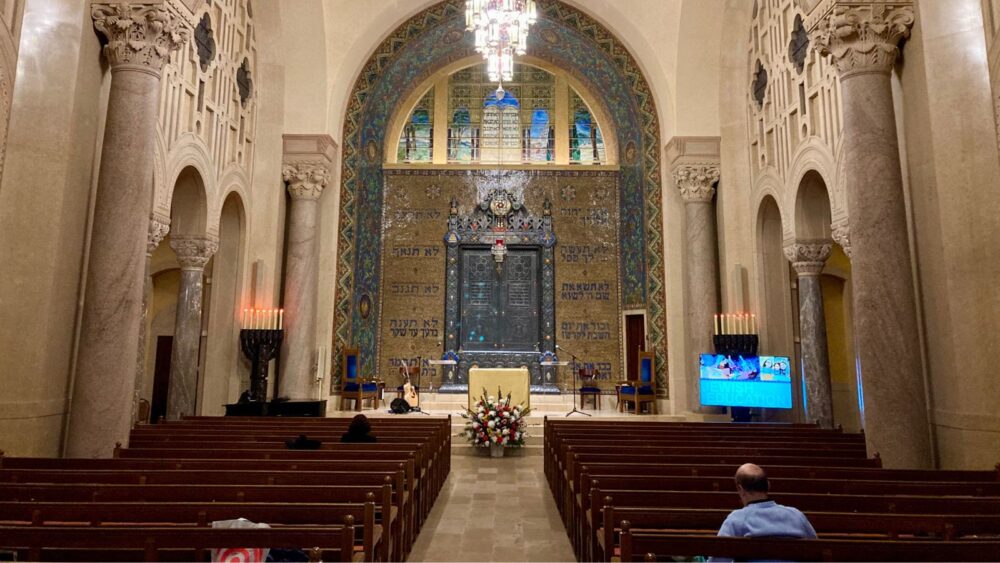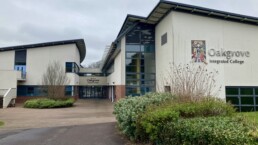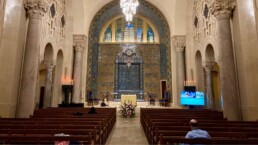Building Bridges: Integrated School Links Religiously Divided Londonderry
LONDONDERRY, Northern Ireland – Culmore Primary School on the outskirts of this religiously divided city advertises itself as a school open to all. The school has three religious education options, including a Catholic program shared with a nearby Catholic primary school.
“We celebrate St. Patrick’s Day, and the Coronation of the Queen and Diwali,” said the principal, Claire McMenamin.
Bringing Catholic and Protestant children together with a sprinkling of Hindus, Muslims, Sikhs, non-believers and others is a relatively new venture in this country which remains part of the United Kingdom.
Culmore Primary is a historically Protestant school located in a Protestant neighborhood. Recent years have seen an influx of Catholic residents and others which prompted McMenamin to initiative a movement for school integration.
The official name for such a change is Transformation, the process of changing a school’s status. The result, as McMenamin put it, would provide a “bridge between our wee school and the rest of the community.”
The school staff brought the question of transformation to parents through a ballot. In December, 90% of parents voted in favor of moving the majority Protestant school to integrated status.
Twenty-six years after the Good Friday Agreement, Northern Ireland’s schools remain overwhelmingly segregated. Around 7% of students are currently educated in integrated schools, according to the UK Department of Education. The remaining 93% are largely split between the Protestant controlled sector and Catholic maintained sector. While these schools are not strictly segregated, and shared education programs have cropped up to encourage relationships between the two sectors, integrated schools are designed to intentionally support religious, cultural, and socioeconomic diversity, according to the UK Department of Education.
Parental ballots are an increasingly popular method for transformation. Twenty-seven schools have hosted successful ballots since 2019, bringing the total number of integrated schools to 71, based on data from the Integrated Education Fund. For some, the integration movement reflects Northern Ireland’s attempts to confront its divided past and invest in a more peaceful future. The movement may also reflect the country’s shifting religious demographics, as a growing number of people choose to identify as neither Catholic nor Protestant.
The idea of the parental ballot has its roots in the first integrated school in Northern Ireland, Lagan College. The school was founded in Belfast in 1981 by a group of parents dissatisfied with the divided education system. The solution, they decided, was to form their own school.
“It was a tremendously courageous initiative,” said Ken Cathcart, director of the Integrated Education Fund. “They remortgaged their houses.”
Integration gained traction, leading to a piece of legislation in 1989 that required the Department of Education to support the development of integrated schools. While this led to more resources for school integration, the government has not played a leadership role in changing the status of schools.
“Because there isn’t this top-down initiative to create integrated schools, parents have had to do it themselves,” said Cathcart.
In 2020, McMenamin noticed that the neighborhood around the school was changing and approached the board of governors and staff about integration. In 2022, she attended a Department of Education event on the transformation process and got to work. The school sent out information on integration to parents, posted materials on Facebook and hosted an information session with a representative from the Integration Education Fund.
Parents were mainly concerned about how religious education and their children’s sense of identity would be affected by transformation, McMenamin said. The teachers were able to assure parents that the different options for religious education would continue.
“It’s not actually a threat to allow your children to be more broad-minded,” said McMenamin. “You’re not losing your identity. You’re celebrating your identity.”
When the ballot went out, McMenamin worried about families across the border in Donegal successfully mailing it back. For the ballot to count, 50% of families must return it, according to the UK Department of Education. Of Culmore Primary School’s 40 families, 76% returned the ballot, the principal said.
To move forward with integration, McMenamin must now submit a document to the minister of education making the case for why the school should transform and proving that it can meet certain requirements. Schools must demonstrate that at least 10% of their first year’s enrollment comes from the area’s minority community, and this percentage should increase over time, according to the Council for Integrated Education. Schools must also have diversity among their staff and board of governors.
Transformation can be slow and burdensome. McMenamin is dedicating one work day each week to the process, on top of her job as a teaching principal. For her, the effort is worth it.
“If we want things to move forward in Ireland, our kids are the future,” she said.
Public support for integration is high, but parents still rank good educational standards as the most important aspect when choosing a school, according to a 2023 poll conducted by the market research company LucidTalk.
A significant barrier to integration is that Northern Ireland’s education system is structured around two sectors that have been operating for over 100 years, said Cathcart. Even procuring a building for an integrated school can be challenging.
The Integrated Education Fund and the Northern Ireland Council for Integrated Education exist to help parents and schools with transformation. Culmore Primary School received grants from these organizations to fund its community outreach.
However, changing the system, and building understanding between people, takes time.
“You can’t go from a single identity school to a multiple identity school overnight,” Cathcart said.
A few days before St. Patrick’s Day, one classroom of students celebrated the holiday with Irish dancing. The students planted their hands on their hips and jumped along in time with a video of a dancing leprechaun projected on the board. OKAY! SOMETHING OF A RITUAL!
Across the river from Culmore Primary School is Oakgrove Integrated College, which was planned as an integrated school by parents in 1992. At lunchtime, a small group of students sit around a table in the principal’s office and share what led them to enroll.
“It was the right thing to do,” said 17-year-old Bobby Skeggs, who has a Catholic mother and Protestant father. “I’m glad that I’m here. I don’t look at a Catholic school and think I wish I were there.”
Students share other reasons for attending: following in the steps of a sibling or continuing on a track set by going to an integrated primary school. Several students, like Skeggs, have parents from different faiths. One student speaks of putting religion behind.
More students are enrolling at Oakgrove Integrated College who do not identify as Catholic or Protestant, said Principal John Harkin. Even so, maintaining religious diversity can be a challenge. About 10% of the school’s youngest class is Protestant, a trend which Harkin describes as worrying.
The school brings in speakers and programs to help educate the students on conflict and reconciliation. A grant from the Integrated Education Fund supported a cricket team, a traditionally Protestant sport and an addition to the school’s other offerings that include rugby and Gaelic football. But coming off the heels of Covid and the government hiatus at Stormont, Harkin thinks the school may be falling behind in its mission.
“There’s lots of things that we need to do to move forward,” he said.
Becoming an Adult at Temple Emanu-El

NEW YORK - “We are on the corner of Fifth and 65 Street in 2024. But now, we are going back to Mount Sinai,” Rabbi Sarah Reines said from the pulpit of Temple Emanu-El during a Shabbat service.
For at Mount Sinai, said Reines, Moses received a sacred scroll that would be passed down through the generations.
This was the cue for 13-year-old Gavin Matlin, who up until this point had been sitting in a chair to the right of the ark, wearing a suit and a tallit, his feet dangling a few inches above the floor. Gavin stood and moved to the front of the bimah.
Reines pulled open the doors of the ark and retrieved the Torah while Gavin’s family — his sister, parents and grandparents, all dressed in trim black suits and dresses — ascended the stairs to the bimah and lined up next to him.
“This is the Torah, a light for our eyes, a lamp for our way,” sang the congregation.
“Our ancestors roamed that desert so many thousands of years ago and they were given this great gift,” Reines said, carrying the Torah scrolls wrapped in a mantle of red velvet with gold tassels. “And you are all here now because someone in your family line loved Judaism and loved their children enough to pass on this gift. Gavin, now it comes to you.”
Reines presented the Torah to Gavin’s grandfather, who, in a sign of veneration, extended a hand to grasp the velvet mantle. Reines stepped forward to the boy’s grandmother, who did the same. The rabbi walked down the line of family, pausing so that each member could touch the Torah.
And so, from generation to generation, the Torah was handed down to Gavin on his Bar Mitzvah.
When the scrolls reached Gavin, he seemed to take in the weight of all that was wrapped in the mantle before him — physically, the first five books of the Hebrew Bible are contained in the scrolls, but in a broader sense, Jewish law and tradition and Matlin’s responsibility to the Jewish community are also there.
After a moment’s pause, he reached out to touch the mantle, before turning and springing toward his sister in a hug.
The boy, a boy no longer in Jewish eyes, embraced each member of his family and walked side by side with Reines to the pulpit, where he read a Torah portion from the Book of Exodus and gave a short speech. Reines then welcomed him as an adult member of the congregation.


